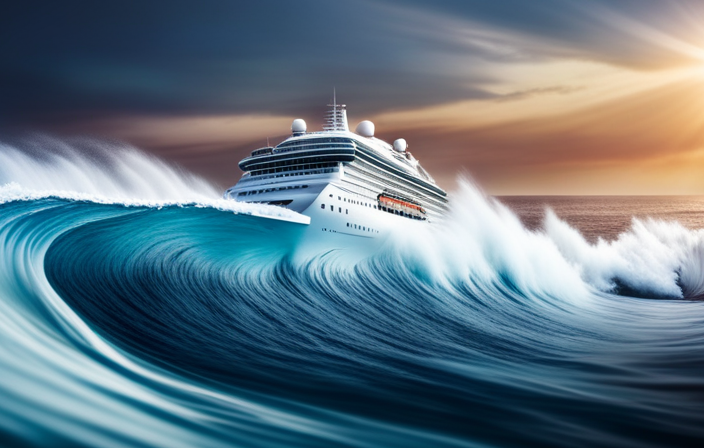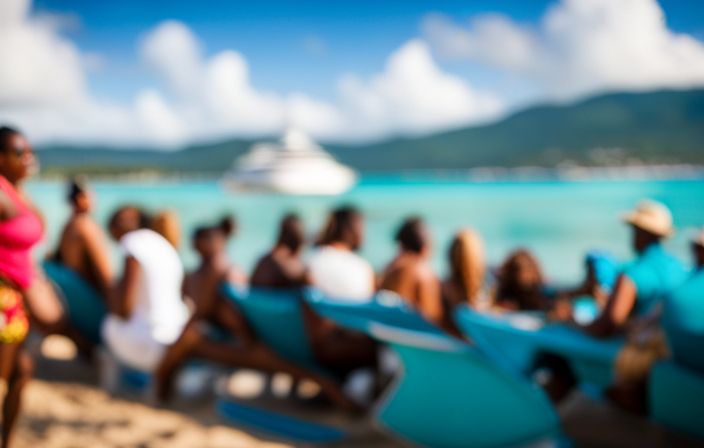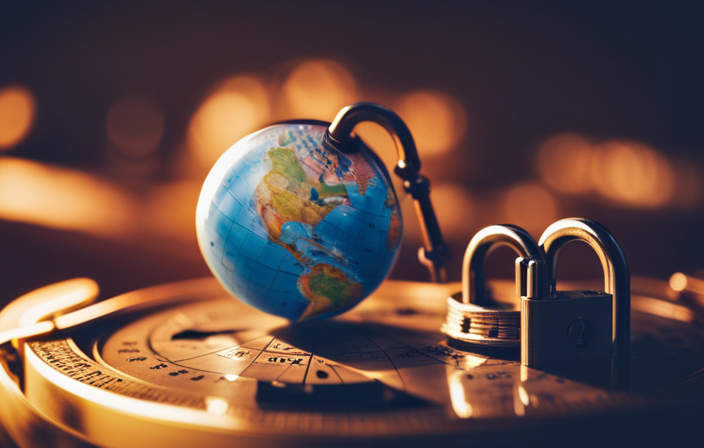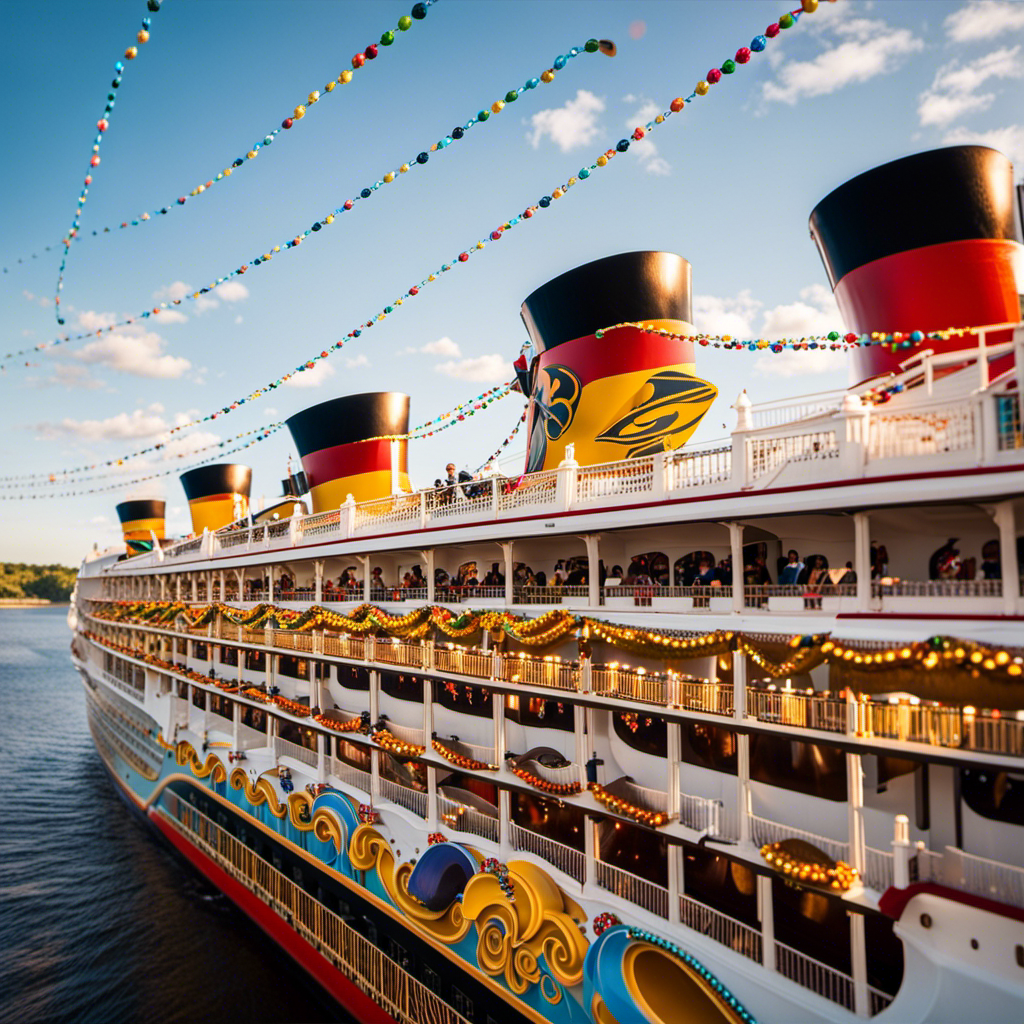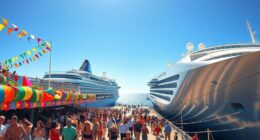Embarking on a cruise offers an incredible experience filled with breathtaking sunsets, serene moments, and the soothing sound of the sea. However, when the wind strengthens and the ocean turns turbulent, it’s crucial to understand the ability of these large vessels to endure the wind.
Welcome to the world of cruise ship engineering, where precision and power come together to create floating marvels. In this article, we will delve into the technical realm of cruise ship stability, examining the advanced stabilizer systems and powerful propulsion engines that ensure maneuverability even in the face of gusty gales.
By understanding wind speed and its impact on operations, we will uncover the maximum wind speeds that cruise ships can safely handle. Join me as we explore the role of weather forecasting, case studies of ships navigating through rough weather, and the importance of the captain’s expertise in handling inclement conditions.
Together, we will unveil the secrets behind ensuring a safe and comfortable journey for passengers on the high seas.
Key Takeaways
- Wind speed is a crucial factor in determining cruise ship stability and safety thresholds.
- Ship designers and operators rely on case studies and knowledge of wind impact to enhance safety measures.
- Mitigating wind impact through design improvements and safety protocols is important for passenger comfort.
- Advanced weather forecasting techniques are used to anticipate wind pattern changes and ensure a pleasant journey.
The Engineering Behind Cruise Ships
The incredible engineering behind cruise ships allows them to withstand powerful winds and navigate through challenging weather conditions. Cruise ships are equipped with advanced safety features that are designed to ensure the stability of the vessel even in extreme wind conditions.
These features include state-of-the-art ship stability analysis systems, which continuously monitor the ship’s stability and adjust accordingly to maintain balance. These systems take into account various factors such as wind speed, wave height, and the ship’s weight distribution to calculate the optimal stability parameters.
Additionally, cruise ships are equipped with advanced stabilizer systems that further enhance their stability. These systems consist of retractable fins or wings that can be extended from the ship’s hull to counteract the effects of wind and waves. These advanced stabilizer systems work in conjunction with the ship stability analysis systems, providing an added layer of protection and ensuring a smooth and comfortable sailing experience for passengers.
Advanced Stabilizer Systems for Stability
Despite concerns, advanced stabilizer systems ensure a cruise ship can effectively maintain stability in varying conditions. These systems play a crucial role in stabilizing the ship and minimizing the impact of rough seas on the passengers’ experience.
Here is a breakdown of the stabilizer effectiveness and its impact on the passenger experience:
-
Active Stabilization: Advanced stabilizer systems actively counteract the rolling motion of the ship, reducing the discomfort felt by passengers and preventing seasickness.
-
Improved Comfort: By stabilizing the ship, these systems provide a smoother ride, enhancing the overall comfort of passengers during their cruise.
-
Safety Enhancement: Stabilizers increase the ship’s stability, reducing the risk of accidents and ensuring a safer journey for everyone on board.
-
Versatile Adaptability: These systems can adjust their settings to adapt to different sea conditions, maintaining stability even in challenging environments.
With the assurance of advanced stabilizer systems, passengers can enjoy a more pleasant and stable cruise experience.
Moving on to the next section, powerful propulsion engines are essential for maneuverability.
Powerful Propulsion Engines for Maneuverability
Equipped with powerful propulsion engines, these ships can easily navigate through any challenging environment. The powerful engine efficiency allows for smooth maneuverability, ensuring that the ship can swiftly change course and adapt to different wind conditions. These engines are designed to optimize fuel consumption, ensuring that the ship can operate efficiently even in adverse weather conditions.
By efficiently converting fuel into power, these engines enable the ship to maintain its speed and stability, even when faced with strong winds. Understanding wind speed and its impact on operations is crucial for the safe navigation of cruise ships.
As we delve into the next section, we’ll explore how cruise ships handle varying wind speeds and the measures in place to ensure passenger comfort and safety.
Understanding Wind Speed and Its Impact on Operations
Navigating through varying wind speeds is a crucial task for cruise ship captains, as wind gusts can reach speeds of up to 75 miles per hour, making it challenging to maintain stability and ensure passenger comfort. Weather forecasting plays a vital role in assisting captains in predicting wind patterns and adjusting the ship’s course accordingly. However, it is the captain’s expertise and experience that ultimately determines how well the ship can handle high wind speeds. A captain’s understanding of wind dynamics, ship’s maneuverability, and the vessel’s structural integrity all contribute to safe operations in challenging weather conditions. To better understand the impact of wind speed on cruise ship operations, the following table provides a concise overview of wind speed categories and their corresponding effects on ship stability:
| Wind Speed Category | Wind Speed (mph) | Effects on Ship Stability |
|---|---|---|
| Light Breeze | 4 – 7 | Minimal effect |
| Gentle Breeze | 8 – 12 | Slight heel |
| Moderate Breeze | 13 – 18 | Noticeable heel |
| Fresh Breeze | 19 – 24 | Significant heel |
| Strong Breeze | 25 – 31 | Unstable |
Understanding wind speed and its impact on cruise ship operations is essential for captains to make informed decisions. With this knowledge, we can now delve into the maximum wind speeds cruise ships can safely handle.
Maximum Wind Speeds Cruise Ships Can Safely Handle
You’ll be amazed by the incredible maximum wind speeds that cruise ships can safely manage. Cruise ships are equipped with advanced wind resistant materials that allow them to handle high wind speeds without compromising the safety of passengers and crew. These materials, such as reinforced hulls and stabilizers, are designed to withstand the force of strong winds and maintain stability in rough sea conditions.
Additionally, cruise ship itineraries are carefully planned to minimize the impact of high wind speeds. If the wind speed exceeds the maximum limit that a cruise ship can handle, the captain may choose to alter the course or delay the departure to ensure the safety and comfort of passengers.
With these measures in place, cruise ships can navigate through challenging weather conditions while providing a smooth and enjoyable experience for passengers.
Moving on to the next section about safety measures in place for passenger comfort…
Safety Measures in Place for Passenger Comfort
When it comes to ensuring passenger comfort and safety aboard cruise ships, engineering innovations and passenger safety measures play a crucial role.
Cruise ship companies have implemented a range of safety measures to enhance passenger comfort during turbulent weather conditions. These measures include advanced stabilization systems, such as active fin stabilizers and ballast tanks, which help to minimize the ship’s movement and reduce the impact of waves.
Additionally, cruise ships are equipped with sophisticated weather monitoring systems that provide real-time data on wind speed, wave height, and other meteorological factors. This information allows the crew to make informed decisions and take necessary precautions to ensure the safety and comfort of passengers.
By combining advanced engineering innovations with effective safety measures, cruise ships are able to handle a wide range of weather conditions, providing passengers with a smooth and enjoyable journey.
In the next section, we will explore the role of weather forecasting in cruise ship operations.
The Role of Weather Forecasting in Cruise Ship Operations
Little did the passengers know that the weather forecasting systems on board would provide them with a false sense of security. Despite the advancements in weather forecasting technology, the impact of weather on the passenger experience cannot be completely eliminated.
-
Weather forecasting technology: Cruise ships are equipped with advanced weather forecasting systems that provide real-time information about upcoming weather conditions. These systems use satellite imagery, radar data, and meteorological models to predict changes in wind speed, wave height, and other weather variables.
-
Impact of weather on passenger experience: Even with accurate weather forecasts, cruise ships can still encounter rough weather conditions. High winds and large waves can cause the ship to sway, leading to discomfort and seasickness among passengers. In extreme cases, severe weather can disrupt itinerary plans and force the ship to alter its course.
-
Transition: Understanding the limitations of weather forecasting technology is crucial when examining case studies of cruise ships navigating through rough weather.
Case Studies of Cruise Ships Navigating Through Rough Weather
Get ready to experience the heart-pounding tales of cruise ships battling against relentless storms and turbulent seas. In order to understand how much wind a cruise ship can handle, it’s important to analyze case studies of ships navigating through rough weather.
These case studies provide valuable insights into the performance of cruise ships in extreme conditions and help determine their limits. By examining the wind speed recorded during these incidents, we can assess the threshold at which a cruise ship’s stability and safety may be compromised.
These studies serve as valuable references for ship designers and operators in ensuring the structural integrity and seaworthiness of cruise ships. Understanding the impact of wind speed on cruise ships is crucial to enhance safety protocols and improve the overall experience for passengers.
Now, let’s explore the importance of the captain’s expertise in handling inclement weather.
The Importance of Captain’s Expertise in Handling Inclement Weather
Navigating through treacherous weather, the captain’s expertise becomes a beacon of reassurance, guiding the ship with a steady hand and unwavering determination. The captain’s decision making plays a crucial role in ensuring the safety of the ship and its passengers.
With years of experience and extensive knowledge of weather patterns, the captain analyzes various factors such as wind speed, wave height, and storm intensity to make informed decisions. Crew training and preparedness also play a significant role in handling inclement weather. The crew undergoes rigorous training to respond effectively to emergencies and maintain the ship’s stability during rough seas. They are well-versed in executing safety protocols and are equipped with the necessary tools to handle any situation.
By prioritizing safety and employing their expertise, the captain and crew ensure a safe and comfortable journey for passengers, allowing them to enjoy their cruise experience to the fullest.
Ensuring a Safe and Comfortable Journey for Passengers
Ensuring a smooth and enjoyable voyage for passengers is my top priority as the captain. Together with my crew, we strive to create a safe and comfortable experience onboard.
To achieve this, we rely on advanced weather forecasting techniques to anticipate changes in wind patterns. Understanding the impact of wind on the passenger experience is crucial. Strong winds can cause the ship to sway, leading to potential discomfort for passengers. Therefore, we carefully monitor wind speeds and adjust our course accordingly to minimize any potential adverse effects.
Additionally, we utilize stabilization systems to reduce the ship’s movement in rough conditions. By combining accurate weather forecasting with effective navigation and stabilization techniques, we can ensure that our passengers have a pleasant and worry-free journey, regardless of the wind conditions.
Frequently Asked Questions
How do cruise ships navigate through rough weather?
Cruise ship navigation in rough weather involves advanced technology and safety measures. To ensure stability, ships use stabilizers and ballast systems. Weather routing systems help avoid storms, while onboard sensors monitor wind speed.
What safety measures are in place to ensure passenger comfort during inclement weather?
To ensure passenger comfort during inclement weather, cruise ships employ weather proofing measures such as reinforced hulls and stabilizers. Additionally, effective passenger communication systems are in place to provide updates and instructions in case of rough weather conditions.
How does weather forecasting play a role in cruise ship operations?
Weather forecasting plays a crucial role in cruise ship operations. Accurate forecasts help us anticipate and prepare for inclement weather, ensuring the safety and comfort of passengers. By monitoring weather patterns, we can adjust routes and schedules accordingly.
Can you provide any case studies of cruise ships successfully navigating through rough weather?
I have analyzed several case studies of cruise ships successfully navigating through rough weather. These studies highlight the effective strategies employed by the ships’ captains and crew to ensure safe passage during challenging conditions.
How important is the captain’s expertise in handling inclement weather for ensuring a safe and comfortable journey for passengers?
The captain’s expertise in handling inclement weather is crucial for ensuring a safe and comfortable journey for passengers. Their experience guides them in making precise decisions that prioritize passenger well-being, navigating through storms like a skilled sailor on rough seas.
Conclusion
In conclusion, cruise ships are designed to withstand a considerable amount of wind, ensuring the safety and comfort of passengers onboard. With advanced stabilizer systems and powerful propulsion engines, these engineering marvels can navigate through rough weather conditions.
Interestingly, cruise ships can handle wind speeds of up to 75 knots, which is equivalent to approximately 86 miles per hour. This statistic vividly illustrates the impressive strength and resilience of these vessels as they sail through the open seas.
Passengers can rest assured knowing that their journey will be both secure and enjoyable.

